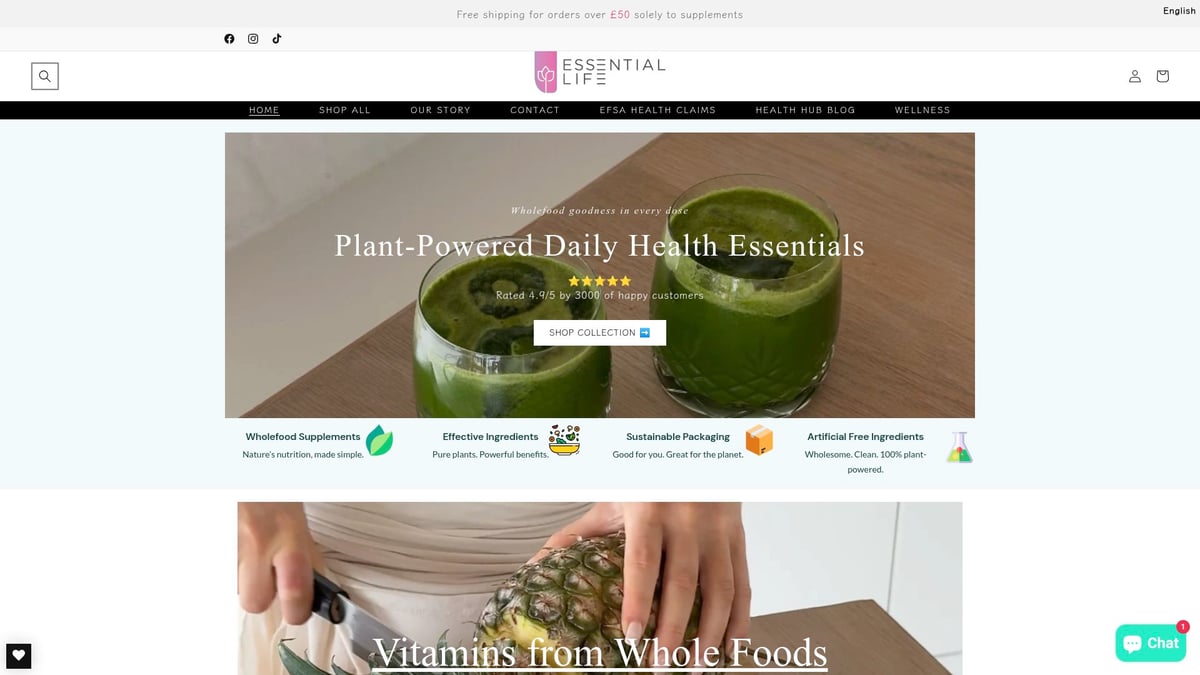
Essential Guide to Vitamins and Supplements for 2025
Share
Confused by the ever-expanding world of vitamins and supplements? You’re not alone. With global sales projected to exceed $200 billion by 2025, more people are seeking answers about the role of vitamins and supplements in their daily lives.
Understanding which options are truly essential can make all the difference for your health, energy, and long-term wellness. Making informed choices is more important than ever.
This essential guide demystifies the latest science, trends, and expert recommendations. You’ll learn the basics, discover key nutrients for 2025, find out how to choose quality products, explore safety considerations, and get a preview of emerging trends.
Let’s get started on your journey to informed, safe, and effective supplementation.
Understanding Vitamins and Supplements: The Basics
Navigating the world of vitamins and supplements can feel overwhelming, especially with so many options available in 2025. To make informed decisions, it is essential to grasp the foundations of what these products are, why people use them, and how your body processes them.

What Are Vitamins and Supplements?
Vitamins and supplements play a crucial role in supporting overall health. Vitamins are organic compounds your body needs for essential functions, such as energy production, immunity, and bone strength. Supplements are products designed to augment your daily diet, filling nutritional gaps or providing extra support for specific needs.
Vitamins fall into two main categories:
| Type | Examples | Solubility |
|---|---|---|
| Water-soluble | Vitamin C, B vitamins | Dissolve in water, not stored long-term |
| Fat-soluble | Vitamins A, D, E, K | Stored in body fat, used as needed |
Supplements come in many forms, including capsules, powders, gummies, and liquids. Alongside vitamins, they may contain minerals (such as iron or magnesium) and botanicals (like echinacea or turmeric). For example, vitamin D acts both as a vitamin and as a hormone precursor, influencing many bodily processes. To explore a wide range of these products, visit the Vitamins and Supplements Collection.
Why Do People Take Supplements?
People turn to vitamins and supplements for several reasons. Modern diets, busy lifestyles, and environmental factors can create nutritional gaps that are difficult to fill with food alone. Supplements help bridge these gaps and target specific health concerns, such as boosting immunity, supporting bone health, or increasing energy levels.
Recent data reveals that over 75% of U.S. adults used supplements in 2024. For instance, vegans often take vitamin B12, while older adults may rely on calcium and vitamin D to maintain bone strength. The widespread use of vitamins and supplements highlights their perceived value in maintaining wellness.
How the Body Absorbs and Utilizes Nutrients
Your body's ability to absorb nutrients from vitamins and supplements depends on several factors. Bioavailability—how well a nutrient is absorbed and used—can be higher in food-based or wholefood supplements. Age, gut health, and medication use also influence absorption.
For example, vitamin C can enhance the absorption of iron from plant sources. Choosing the right form of vitamins and supplements ensures you get the most benefit from what you take.
The Role of Diet vs. Supplements
While vitamins and supplements offer valuable support, whole foods should remain your primary nutrient source. Foods provide a complex mix of vitamins, minerals, and cofactors that work together for optimal health. Supplements act as a bridge when dietary gaps exist, but they should never replace balanced meals.
It is important to be cautious about overusing vitamins and supplements, as excessive intake may cause unwanted side effects or health risks. Always aim for balance and prioritize quality nutrition from food first.
Key Vitamins and Supplements for 2025: What You Need to Know
Choosing the right vitamins and supplements for 2025 can feel overwhelming with so many options available. Understanding which nutrients matter most, how trends are evolving, and what your body truly needs, is key to making confident choices. Let’s break down the essentials, highlight science-backed options, and explore how personalized approaches are shaping supplementation this year.

Essential Vitamins for 2025
Several vitamins and supplements remain essential for optimal health in 2025. Vitamin D continues to top the list, as new research highlights its role in immunity, bone strength, and mood regulation. Many people struggle to get enough from sunlight or diet alone, making supplementation important.
Vitamin B12 is crucial for energy production and neurological health. Deficiencies are especially common among vegans and older adults. Vitamin C is valued for its immune-boosting and antioxidant properties, particularly during cold and flu season. Vitamin K2 is gaining attention for supporting bone and cardiovascular health, based on emerging scientific studies.
For more insights on immune-supporting nutrients, see these Tips for Boosting Immune System. Selecting the right vitamins and supplements for these core areas can make a measurable difference in daily wellbeing.
Trending Supplements Backed by Science
In 2025, several supplements stand out due to strong scientific backing. Omega-3 fatty acids, found in fish oil and algae oil, are linked to heart, brain, and eye health. Magnesium supports stress reduction, restful sleep, and muscle function, making it a favorite for those with busy lifestyles.
Probiotics continue to gain popularity for their role in gut health, immunity, and even mood regulation. High-potency options are now widely available. Collagen supplements, sourced from marine or bovine origins, are embraced by those seeking joint comfort, skin elasticity, and stronger hair.
Choosing evidence-based vitamins and supplements ensures you benefit from the latest research and avoid hype-driven products. Always look for clinical data supporting any trending supplement you consider.
Addressing Common Deficiencies
Deficiencies in key vitamins and supplements remain a widespread concern in 2025. Vitamin D deficiency is still prevalent, particularly in northern climates or among those with limited sun exposure. Common symptoms include fatigue, weakened immunity, and bone discomfort.
Iron is another critical nutrient, especially for women of reproductive age. Low iron can cause tiredness, pale skin, and impaired concentration. Folate is essential for pregnancy and cellular growth, with deficiency posing risks for both mother and baby.
Being aware of these common gaps can guide your choices. Testing and professional guidance help ensure you select the right vitamins and supplements to address your unique needs.
Personalized Supplementation
Personalization is transforming how people approach vitamins and supplements in 2025. Advances in genetic testing and nutrition analysis allow for plans tailored to your DNA, age, gender, and lifestyle. This targeted approach helps minimize unnecessary supplementation and maximize results.
Consider factors such as your health status, activity level, and dietary preferences when building a supplement routine. Personalized options are increasingly accessible, offering recommendations based on scientific data and your individual profile.
By embracing a personalized strategy, you ensure the vitamins and supplements you choose are both safe and effective for your specific situation. Regular reassessment keeps your plan aligned with your changing needs and the latest evidence.
Choosing Quality Vitamins and Supplements: What to Look For
Navigating the crowded market of vitamins and supplements requires a keen eye for quality and transparency. With countless options on the shelves, understanding what sets top-tier products apart is essential for making informed choices. Let us break down the critical factors to consider as you select the right vitamins and supplements for your needs.
Understanding Labels and Certifications
When shopping for vitamins and supplements, start by examining the supplement facts panel. Look for clear ingredient lists, serving sizes, and active nutrient amounts. Certifications such as USP, NSF, or Informed Choice indicate third-party testing, which ensures product purity and potency.
Be wary of unfamiliar additives or fillers, as these may reduce the effectiveness of vitamins and supplements. Transparent labeling is a hallmark of reputable brands, giving you confidence in what you are consuming.
Food-Based vs. Synthetic Supplements
The debate between food-based and synthetic vitamins and supplements continues to shape consumer choices. Food-based supplements often provide higher bioavailability, meaning your body can absorb nutrients more efficiently. They are also gentle on digestion and may include natural co-factors that enhance absorption.
For a deeper comparison of these supplement types, see Food-Based vs. Synthetic Supplements. Understanding this distinction helps you prioritize the best format for your health.
Why Choose Plant-Based, Wholefood Supplements?
Plant-based, wholefood vitamins and supplements offer unique advantages. They are typically free from artificial colors, sweeteners, and common allergens. These supplements suit individuals with sensitive digestion and those following vegan or allergen-free diets.

Additionally, many plant-based brands use eco-friendly packaging, supporting both personal wellness and environmental sustainability. Choosing wholefood supplements aligns with a holistic approach to health.
Spotting Red Flags
Not all vitamins and supplements are created equal. Watch for these warning signs:
- Proprietary blends with undisclosed ingredient amounts
- Exaggerated health claims not supported by evidence
- Lack of third-party certifications
- Poor transparency or missing customer reviews
A cautious approach protects your health and helps you invest in products you can trust.
Cost vs. Value
Price is not always an indicator of quality when it comes to vitamins and supplements. Consider the daily cost per serving, actual nutrient content, and whether the product meets your specific needs.
Look for brands that balance affordability with high standards. Investing in quality ensures you get the maximum benefit from your vitamins and supplements without overspending.
Safety, Dosage, and Expert Recommendations
Navigating the world of vitamins and supplements in 2025 requires a thoughtful approach to safety and efficacy. With so many options on the market, understanding how to use these products wisely is essential for protecting your health and achieving optimal results.

Determining the Right Dosage
Finding the correct dosage for vitamins and supplements is crucial. Recommended Dietary Allowances (RDAs) guide daily intake, while Tolerable Upper Intake Levels (ULs) indicate the maximum safe amount. Exceeding these limits may cause toxicity, especially with fat-soluble vitamins like vitamin A or minerals like iron. While some individuals consider "megadosing," this practice can be risky. Balanced supplementation, as discussed in Achieving Balance with Multivitamins, supports overall health without overloading the body. Always tailor your intake to personal needs, and review supplement facts to avoid unintentional excess.
Who Should (and Shouldn’t) Take Supplements?
Not everyone benefits equally from vitamins and supplements. Children, pregnant women, the elderly, and individuals with chronic illnesses often have unique requirements. Consulting a healthcare professional before starting any new supplement is vital, as underlying health conditions or medications may influence nutrient needs. Some populations, like vegans, require specific vitamins such as B12, while others may need tailored mineral support. Remember, vitamins and supplements should complement, not replace, a balanced diet and medical advice.
Interactions and Side Effects
Vitamins and supplements can interact with medications or other nutrients, sometimes leading to adverse effects. For example, vitamin K may interfere with blood thinners, and calcium can affect the absorption of certain antibiotics. Side effects like digestive upset or allergic reactions are possible, with magnesium sometimes causing diarrhea if overused. Always monitor your body's response, and inform your healthcare provider about all vitamins and supplements you take to minimize risks.
Regulatory Landscape in 2025
The regulatory environment for vitamins and supplements continues to evolve. Agencies such as the FDA in the United States and EFSA in Europe oversee product safety, labeling, and quality standards. In 2025, recent updates have further emphasized transparency and consumer protection, including more frequent recalls and stricter safety advisories. Staying informed about regulatory changes and seeking products with third-party certifications helps ensure the vitamins and supplements you choose are safe and reliable.
Expert Tips for Safe Supplementation
To get the most from your vitamins and supplements, follow these expert guidelines:
- Keep a supplement diary to record intake and effects.
- Introduce new products one at a time to identify any reactions.
- Use only evidence-based resources for information.
- Reassess your needs regularly with a healthcare provider.
- Choose brands that offer transparent labeling and third-party testing.
Making informed decisions empowers you to benefit from vitamins and supplements while minimizing risks.
Emerging Trends and Innovations in 2025
The landscape of vitamins and supplements is evolving rapidly in 2025, shaped by new research, technology, and shifting consumer priorities. With the global market expanding and consumer interest rising, innovation is at the forefront. According to Vitamin and dietary supplement market trends 2025, the industry is seeing significant growth, driven by demand for personalization, sustainability, and transparency.
Personalized Nutrition and Supplementation
Personalized nutrition is transforming how individuals approach vitamins and supplements. Advances in genetic and microbiome testing now enable tailored supplement recommendations based on unique DNA and gut profiles. Many people use apps and online services to receive ongoing, data-driven guidance, making their supplement routines more targeted and efficient. This trend empowers consumers to address specific health goals and deficiencies with precision.
Sustainable and Clean Label Supplements
Sustainability is a major focus for those choosing vitamins and supplements in 2025. Brands are prioritizing eco-friendly packaging and ethically sourced ingredients. Essential Life, for example, champions plant-based formulas and recyclable materials, reflecting a broader industry commitment to environmental wellness. Clean labels with transparent ingredient lists are in high demand, as consumers look for purity and responsibility in every purchase.
Innovative Delivery Formats
Innovation in delivery is making vitamins and supplements easier and more enjoyable to take. Gummies, sprays, patches, and drinkable powders cater to different preferences and lifestyles. Nanotechnology is also improving absorption rates, allowing the body to utilize nutrients more efficiently. These advances remove barriers to daily compliance and help users integrate supplements seamlessly into their routines.
Functional Blends and Adaptogens
Formulas combining vitamins, minerals, and botanicals are rising in popularity, offering targeted benefits for stress, sleep, and focus. Adaptogens like ashwagandha, rhodiola, and maca are frequently included in blends to support resilience and balance. This approach reflects a holistic view of health, where vitamins and supplements work together to address both physical and mental wellbeing.
Digital Health Integration
Digital tools are playing an increasing role in how people manage their vitamins and supplements. Wearables and apps now track nutrient intake, suggest adjustments, and monitor health outcomes in real time. Telehealth consultations make professional guidance more accessible, ensuring safe and effective supplement use. This integration of technology supports a more informed and proactive approach to nutrition.
Consumer Education and Transparency
Consumers are demanding clear, science-backed information about their vitamins and supplements. Educational campaigns, transparent labeling, and access to professional advice are helping people make informed decisions. As the industry grows, brands that prioritize honesty and evidence-based guidance are earning greater trust and loyalty among health-conscious individuals.
How to Build Your Personalized Supplement Routine: Step-by-Step
Building an effective, personalized approach to vitamins and supplements can feel overwhelming, but a clear process can help you make confident, science-based choices. With consumer interest at an all-time high and the vitamin supplement market growth projections for 2025 continuing to climb, taking the right steps is more important than ever.
Step 1: Assess Your Individual Needs
Start by evaluating your personal health profile. Consider your age, gender, dietary patterns, activity level, and any current health concerns. Blood tests or a professional dietary analysis can reveal specific nutrient gaps that vitamins and supplements may help fill.
Keep a notebook or use an app to record your daily habits. This baseline will guide your choices and ensure you focus on the most relevant nutrients for your unique needs.
Step 2: Consult a Healthcare Professional
Before adding new vitamins and supplements, speak with a healthcare provider, such as a registered dietitian or physician. They can interpret your test results, discuss your health goals, and identify any potential interactions with medications or preexisting conditions.
A professional’s guidance is especially important if you are pregnant, managing a chronic illness, or considering supplements for children or older adults.
Step 3: Choose High-Quality Products
Select supplements from reputable brands that provide transparent labeling, third-party testing, and clear ingredient sourcing. Look for certifications such as USP or NSF to verify quality.
Food-based or allergen-free vitamins and supplements often offer better absorption and fewer side effects. Always check the serving size, daily value percentages, and avoid unnecessary additives.
Step 4: Start Slow and Monitor Effects
Introduce one new supplement at a time. This allows you to track your body’s response and watch for any side effects, such as digestive changes or allergic reactions.
Use a journal to note changes in energy, sleep, mood, or any new symptoms. Adjust your routine based on these observations to ensure your vitamins and supplements are supporting your health effectively.
Step 5: Reassess and Adjust Regularly
Your needs can change over time due to age, life events, or shifts in health status. Reevaluate your supplement routine every six to twelve months, or after major changes like pregnancy, new medications, or a significant shift in activity level.
Stay informed about new research and recommendations. This will help you refine your vitamins and supplements strategy for ongoing benefits.
Step 6: Combine Supplements with a Balanced Diet
Supplements work best when paired with a nutrient-rich diet. Focus on whole foods as the foundation of your health, and use vitamins and supplements to address specific gaps rather than as substitutes.
Aim to eat a variety of fruits, vegetables, whole grains, and lean proteins to maximize nutrient intake and long-term wellness.
Step 7: Stay Informed and Empowered
Keep learning about the latest science, safety updates, and best practices for supplement use. Rely on evidence-based resources and consult with healthcare professionals as your needs evolve.
By following these steps, you can create a vitamins and supplements routine that is safe, effective, and fully tailored to your personal health journey.
Summary Table: Steps for Building Your Personalized Supplement Routine
| Step | Action | Key Focus |
|---|---|---|
| 1 | Assess Individual Needs | Identify gaps/goals |
| 2 | Consult a Healthcare Professional | Ensure safety & efficacy |
| 3 | Choose High-Quality Products | Quality, transparency |
| 4 | Start Slow and Monitor Effects | Track tolerance, effects |
| 5 | Reassess and Adjust Regularly | Adapt to changing needs |
| 6 | Combine with a Balanced Diet | Whole foods as foundation |
| 7 | Stay Informed and Empowered | Ongoing education |
